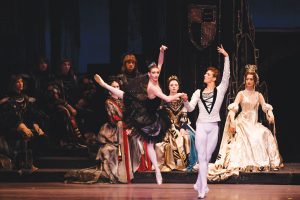Bolshoi Ballet: Grigorovich / Giselle, Swan Lake & Ratmansky / Flames of Paris - Vancouver Ballet Society
- Home
- Reviews 2014 - 2019
- Bolshoi Ballet: Grigorovich / Giselle, Swan Lake & Ratmansky / Flames of Paris

When Makhar Vaziev took over the Bolshoi last year, he declared that classical ballet was and will always remain the company’s lifeline. And so it was when the Bolshoi toured to Japan in June, where a program of classics — Giselle, Swan Lake and Flames of Paris — dominated over 12 days of performances at Tokyo Bunka Kaikan concert hall.
In Giselle, when Evgenia Obraztsova runs, her body sways laterally, arms rippling like bloomed heather rocked by gentle wind. There is a spring breeze in her step and she has an upper body for all seasons. In spectral afterlife she resembled a living Romantic lithograph. There were moments in Act 1, though, when Obraztsova’s dancing seemed distant, filtered through the prettiness of her own enchantment.
That was partly because Yuri Grigorovich’s production lacked narrative detail; if Act 2 is traditionally a metaphorical ballet blanc, his version also treats Act 1 as metaphor. Our protagonists appear like parting mist, we know little of their histories and the narrative never really builds. It’s also partly because Igor Tsvirko, a fine partner, is a more natural demi-character dancer, and lacked distinction as the prince, Albrecht.
If Obraztsova took the more picturesque approach to Giselle, Ekaterina Krysanova strained for naturalism. With Krysanova, there were moments both private and irrepressible, but there were also phases when she seemed almost vacant, subdued. At the start of the Act 1 variation, she turned her face upward to gaze dreamily as if lost in private reverie. You wished she sustained those thoughts. Without an illuminating inner life, much of her restrained inner passion felt like studied impressionism, something performed rather than inhabited. But no matter. Krysanova’s time came at the end of the tour in Flames of Paris.
As her Albrecht, Vladislav Lantratov found the right balance between the character’s arrogance and redemptive sincerity. He had the entitled air of nobility without being wholly unsympathetic; careless but not malicious. They were joined by Alena Kovaleva’s debut as Myrtha. Kovaleva, a 2016 Vaganova graduate, is an intriguing dancer, whose exquisite physical gifts and épaulement come without a matching technical refinement. It should be interesting to follow her progress.
The lighter, more traditional treatment Grigorovich gives Giselle turns noir-ishly opaque in his Swan Lake. On the one hand, it indulges in casual truths — good versus evil, black versus white — and by eliminating mime it tries too hard for grand abstraction. On the other hand, it burdens an allegorical narrative with pop psychology; its Othello-like psychological play is a promising premise, but is executed without Shakespearean complexity. To transcend the production’s limitations takes a special performance — and special Olga Smirnova and Semyon Chudin certainly were.
Smirnova has this extra dimensionality, a thorough body eloquence that is replete with pathos, and arms that are whisperingly beautiful. Chudin partnered with the silkiest of touch and danced with epicurean ease. For the length of the white adagio, neither the production’s idiosyncrasies nor anything else in the world mattered.
That Smirnova and Chudin are a seasoned pairing was yet more obvious when watching Yulia Stepanova and Artem Ovcharenko in a later performance. Individually, they were lovely. Ovcharenko had brooding elegance, and Stepanova, who generated drama with powerful, undulating arms and sculpted shapes, had both allure and freshness. But the duets felt laboured and musically unvaried.
Watching the St. Petersburg-trained Smirnova or Stepanova lead a flock of Moscow swans is a reminder, too, that despite centuries of crossover, real differences exist between the schools from the former imperial capital and its Soviet usurper. Dancers like these enrich any company, and the Bolshoi is large enough and its style broad enough to contain those differences. It shouldn’t, though, forget its own identity.
The Flames of Paris is what the Bolshoi does best — exuberant spectacle. Drawing on the existing 25 minutes of Vasily Vainonen’s choreography with a reimagining of the original libretto, Alexei Ratmansky’s 2008 production is kitsch without nostalgia. In the original, moral binaries framed by class polemics drove the revolutionary cauldron; here the Bolshoi dancers give us the glory and heroism, but ask questions of it, too.
Krysanova, finding nuance within bravado, was a blazing Jeanne with Denis Savin a touching Jerome. David Motta Soares and Margarita Shrainer made delicious work of the court divertissement.
There is one more thing. Character dances, a cherished tradition which Grigorovich’s Swan Lake inexplicably dispenses with, are restored to their rightful place in Flames of Paris. Vainonen’s production had both a martyr-like character, Marianne, and a classical lead, Jeanne, but Ratmansky combines the two, giving Marianne’s passages — which would have been danced by a character specialist — to Jeanne. The use of weight in character and classical dance is different, and Krysanova brought to these passages less heroic weight in favour of a lightness, an ecstatic rapture. Lantratov’s Philippe, more spindly than a Chabukiani, the role’s originator, was the revolution’s freewheeling spirit, an incarnation of populist joie de vivre.
Fervour and gravitas, these two dancers seemed to tell us, are different things. Ratmansky adds, through a twist of an ending, that we would do good not to confuse them.
— JOY WANG XIN YUAN
DI FALL 2017

Photo: Courtesy of Japan Arts
